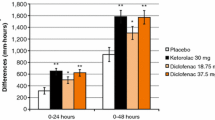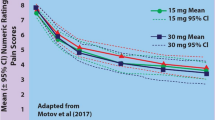Abstract
Background
More than two-thirds of patients with metastatic cancer experience pain. Tramadol is one of the most interesting and useful weak opioids used by palliative care units to treat moderate to moderately severe pain. Relief of distressful symptoms in terminally ill patients is of prime importance; a common practice is to administer opioid analgesics in conjunction with other drugs as hyoscine N-butyl bromide, which is very useful in reducing secretions in patients with inoperable malignant bowel obstruction. The pursuit for excellence in symptom control in patients unable to take oral medication has led to the administration of medications by other routes such as the subcutaneous route.
Purpose
The purpose of this study was to fulfill the lack of information regarding the compatibility and physical stability of tramadol hydrochloride and hyoscine N-butyl bromide combined in infusion solutions.
Methods
The stability of nine admixtures (stored in polypropylene syringes) at 4 and 25°C was assessed over a period of 15 days.
Results
Nonstatistically significant losses of tramadol HCl and a maximum loss of 7% for hyoscine N-butyl bromide were obtained. Therefore, tramadol HCl (dose range, 100–400 mg/day) can be formulated together in saline with hyoscine N-butyl bromide (dose range 40–80 mg/day) for s.c. infusion using a 60-ml drug infuser for a duration of 7 days.
Similar content being viewed by others
References
Care pain relief and palliative care (1990) Technical report series 804, WHO, Geneva
Wagner DS, Johnson CE, Cichon-Hensley BK, DeLoach SL (2003) Stability of oral liquid preparations of tramadol in strawberry syrup and a sugar-free vehicle. Am J Health Syst Pharm 60:1268–1270
Leppert W, Luczak J (2005). The role of tramadol in cancer pain treatment—a review. Support Care Cancer 13: 5–17
Klotz U (2003) Tramadol—the impact of its pharmacokinetic and pharmacodynamic properties on the clinical management of pain. Arzneimittelforschung 53:681–687
De Conno F, Panzeri C, Brunelli C, Saita L, Ripamonti C (2003) Palliative care in a national cancer center: results in 1987 vs. 1993 vs. 2000. J Pain Symptom Manage 25:499–510
Klepstad P, Kaasa S, Cherny N, Hanks G, de Conno F (2005) Pain and pain treatments in European palliative care units. A cross sectional survey from the European Association for Palliative Care Research Network. Palliat Med 19:477–484
Grond S, Radbruch L, Meuser T, Loick G, Sabatowski R, Lehmann K (1999) High-dose tramadol in comparison to low-dose morphine for cancer pain relief. J Pain Symptom Manage 18:174–179
Herndon CM, Fike DS (2001) Continuous subcutaneous infusion practices of United States hospices. J Pain Symptom Manage 22:1027–1034
McCaffery M, Pasero C (1999) Pain: clinical manual, 2nd edn. Mosby, St Louis, pp 161–299
Thorsen AB, Yung NS, Leung AC (1994) Administration of drugs by infusion pumps in palliative medicine. Ann Acad Med Singapore 23:209–211
Ripamonti C, Mercadante S, Groff L, Zecca E, De Conno F, Casuccio A (2000) Role of octreotide, scopolamine butylbromide, and hydration in symptom control of patients with inoperable bowel obstruction and nasogastric tubes: a prospective randomized trial. J Pain Symptom Manage 19:23–34
De Conno F, Caraceni A, Zecca E, Spoldi E, Ventafrida V (1991) Continuous subcutaneous infusion of hyoscine butylbromide reduces secretions in patients with gastrointestinal obstruction. J Pain Symptom Manage 6:484–486
Abamy NO, Zaghlouol IY, Radwan MA (2005) Compatibility of tramadol hydrochloride injection with selected drugs and solutions. Am J Health Syst Pharm 62:1299–1302
Negro S, Martín A, Azuara ML, Sanchez Y, Barcia E (2005) Stability of tramadol and haloperidol for continuous home s.c. infusion. J Pain Symptom Manage 30:192–199
Jappinen A, Turpeinen M, Kokki H, Rasi A, Ojanen T, Pelkonen O, Naaranlahti T (2003) Stability of sufentanil and levobupivacaine solutions and a mixture in a 0.9% sodium chloride infusion stored in polypropylene syringes. Eur J Pharm Sci 19:31–36
Gan SH, Ismail R, Wan Adnan WA, Wan Z (2002) Method development and validation of a high-performance liquid chromatographic method for tramadol in human plasma using liquid–liquid extraction. J Chromatogr B Analyt Technol Biomed Life Sci 772:123–129
Center for Drug Evaluation and Research (1994) Reviewer guidance: validation of chromatographic methods. US FDA, MD, USA
ICH Q2B (1995) Validation of analytical procedures: methodology. Center for Drug Evaluation and Research, FDA, MD, USA
Hopkins D, Shipton EA, Potgieter D,Van der Merwe CA, Boon J, De Wet C, Murphy J (1998) Comparison of tramadol and morphine via subcutaneous PCA following major orthopaedic surgery. Can J Anaesth 45:435–442
Lewis G, Hecker J (1985) Infusion thrombophlebitis. Br J Anaesth 57:220–223
Fransson J, Espander-Jansson A (1996) Local tolerance of subcutaneous injections. J Pharm Pharmacol 48:1012–1015
Zaghlouol IY, Radwan MA (1997) High performance liquid chromatography determination of tramadol in pharmaceutical dosage forms. J Liq Chromatogr Relat Technol 20:779–787
Peterson GM, Miller KA, Galloway JG, Dunnet PF (1998) Compatibility and stability of fentanyl admixtures in polypropylene syringes. J Clin Pharm Ther 23:67–72
Database of drug compatibility for syringe drivers (2001) http://www.pallmed.com. Accessed January 2006
Schrijvers D, Tai-Apin C, De Smet MC, Cornil P, Vermorken JB, Bruyneel P (1998) Determination of compatibility and stability of drugs used in palliative care. J Clin Pharm Ther 23:311–314
Barcia E, Reyes R, Azuara ML, Sánchez Y, Negro S (2003) Compatibility of haloperidol and hyoscine-N-butyl bromide in mixtures for subcutaneous infusion to cancer patients in palliative care. Support Care Cancer 11:107–113
Acknowledgement
The authors wish to thank Grünenthal for the supply of tramadol hydrochloride.
Author information
Authors and Affiliations
Corresponding author
Rights and permissions
About this article
Cite this article
Barcia, E., Martín, A., Azuara, M.L. et al. Tramadol and hyoscine N-butyl bromide combined in infusion solutions: compatibility and stability. Support Care Cancer 15, 57–62 (2007). https://doi.org/10.1007/s00520-006-0101-2
Received:
Accepted:
Published:
Issue Date:
DOI: https://doi.org/10.1007/s00520-006-0101-2




